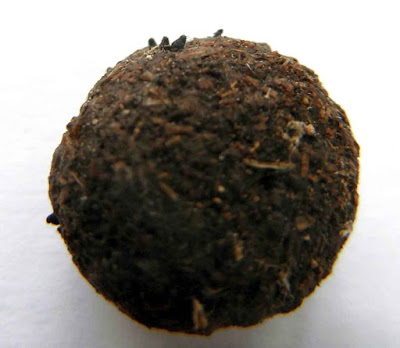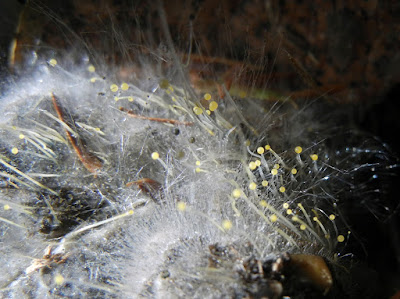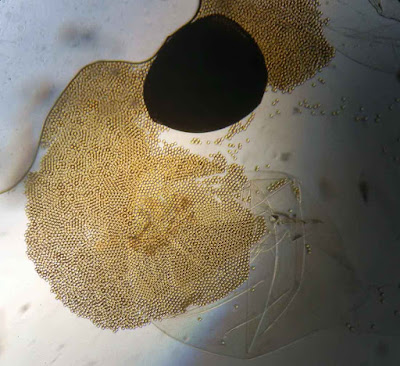 |
| A large colony of Pilobolus, also called the Hat Thrower or Dung Cannon |
I don’t want to offend anyone’s delicate sensibilities (or maybe I do!), but this post is about poo. More specifically, it’s about a secret world that grows on poo, a secret world than can be fascinating and sometimes—of all things!—strikingly beautiful.
 |
| This Eyelash Cup (Cheilymenia stercorea) grew on deer droppings. |
I'm talking about coprophilous, or dung-loving, fungi. These fungi are our friends, as are all decomposers. They help dispose of what we don't want to see, breaking it down until it's nutritious compost—for the forest floor, the field, the garden.
Some coprophiles are big. A few, like portobello and button mushrooms are good edibles (you did know that they're grown on a pasteurized substrate that contains manure, didn't you?). But most are so tiny you need a magnifying glass to see them. These are the guys I'm interested in.
 |
| This deer pellet has three species growing on it. The tiny white ones grew into the smallest gilled mushrooms I've ever seen. |
Right now, in fact, I'm trying to grow some of these mini characters on what used to be our dining-room table.
About a week ago I was given a few samples of dried animal dung that are older than I am. At one time, these bits of dung had been studied, and then dried and stored, because interesting little fungi had been growing on them. The question is, are the spores that this dung holds still viable? Will fresh fungi appear? I have a bit of cow, goat, deer and rabbit dung, each now rehydrated and sitting in a moist chamber. Not much is happening yet, but I have high hopes.
 |
| The wee black cones at the top of this rabbit pellet are a kind of Podospora. |
These samples I'm nursing originally grew either nondescript lumps called Sporormiella (a Latin genus that when spoken aloud makes you sound drunk) or cuter ones from the genus Podostroma. I found some Podostroma a couple of years ago on a rabbit pellet. Though it's not the prettiest fungus, it has very nifty black spores that sport see-through tails.
 |
| A Podospora spore—with see-through tails at both ends! |
The Royal Ontario Museum's fungarium has an immense collection of fungi, over half a million, a large proportion of which are dung-lovers, because one of the early directors of the collection, Roy F. Cain, was a world-renowned dung-loving fungi lover. But what's to love about about these lowly characters?
 |
| I found this amazing furry Phycomyces fungus on raccoon scat. |
My favourite is Pilobolus, also known as the hat-thrower or cannon fungus. These sparkling jewels don't look very fungal. Each has a skinny stem that rises only a few millimetres above the cow patty or horse puck it grows on. At the top of the stem there's a bulbous, transparent, fluid-filled "head," a head that wears a black "hat." Clustered beneath the hat are its spores.
 |
| Close up of the Hat Thrower or Dung Cannon |
 |
| Pilobolus head & spore capsule "hat" under the microscope |
 |
| When I squashed it under a slide cover, the spores were released. |
 |
| The black dots are Pilobolus spore capsules or "hats" that stuck to the wall of the plastic container I put the horse dung in. |
How can you not love dung-loving fungi when there are characters like this around?
If you'd like to read more about Pilobolus and other fascinating fungi, (including a couple of other dung-lovers—Eyelash Cups on Moose and Deer Droppings and A Poop and Scoop Cup Fungus), check out my fungi blog, Weird & Wonderful Wild Mushrooms.
No comments:
Post a Comment